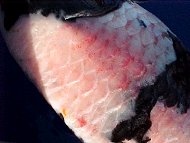|
Nuflor Scald
+ Article on NuFlor
+ Click the pics for larger version
Question:
"My fish had a bad body-sore or ulcer near the anal fin and one near the pectoral fin. I cleaned up the wounds with hydrogen peroxide and injected the fish with NuFlor. A few days later the fish got worse, turning pink from head to tail. The eyes got cloudy and the skin took on a raspberry hue. The tail is tomato red and the edge is rough. Why didn't the NuFlor stop the bacteria?"
Answer:
 Chances are good that the Nuflor DID stop the bacteria in its tracks. Results with Nuflor are, and have been EXCELLENT. But sometimes a fish gets "NuFlor Scald" which seems to happen in fish which are Kohaku or Utsuri derived. (Some people maintain that all Utsuris are Showa derived and I can't say they are wrong). Chances are good that the Nuflor DID stop the bacteria in its tracks. Results with Nuflor are, and have been EXCELLENT. But sometimes a fish gets "NuFlor Scald" which seems to happen in fish which are Kohaku or Utsuri derived. (Some people maintain that all Utsuris are Showa derived and I can't say they are wrong).
Your fish looks and sounds like CLASSIC Nuflor scald. It's the rare fish that gets this, but when they do, the skin *and* tail look EXACTLY like that. In fact, that is SO consistent that I'd like to use one of the pictures to *show* people exactly what the occasional Nuflor scald looks like.
Here's some recommendations for your consideration:
- NO more peroxide on the skin.
- Inject every third or fourth day with Baytril OR Azactam but NOT amikacin. (Eventual cumulative toxicity)
- Keep the fish eating.
- Get the fish into green water if possible, maybe just by killing the UV.
- The redness will not change, and will last for well over a month while the fish essentially acts like nothing is wrong. Never better or never worse.
 There's some thought that the Nuflor scald may actually be a photosensitivity or solar dermatitis. The fish becomes sensitive to the sunlight and actually gets a sunburn. There are many medications which affect people and animals this way. For this reason, keeping the fish in green water or out of direct sunlight might be helpful. There's some thought that the Nuflor scald may actually be a photosensitivity or solar dermatitis. The fish becomes sensitive to the sunlight and actually gets a sunburn. There are many medications which affect people and animals this way. For this reason, keeping the fish in green water or out of direct sunlight might be helpful.
Signs of redness normally show up five days after injection. The reaction is EXTREMELY rare. Other causes of continued redness should be evaluated. (Water quality and continued parasitism)
There are only 5 things which seem to make any difference to these guys once you're sure that the condition is Nuflor scald.
1. Lymnozyme (to reduce the ubiquitous population of Aeromonas and Pseudomonas in the environment and reduce chances for a secondary bacterial infection in the raw skin on the fish.
2. One pound of salt (no more!) per 100 gallons of water.
3. MediKoi (also to prevent the raw red skin from infecting secondarily).
4. Keep the fish OUT of the sun - science does not know if the fish are suddenly sensitive to the sun or if Nuflor is primarily the cause of the problem.
5. Keep in ideal conditions essentially out of the sun for three weeks at a minimum, then return to the main system.
For a time, it's normal that the fish will quit eating. If the 'fast' lasts more than a few days, the fish should be entubated and fed.
 Abstract of Nuflor: NuFlor is a Schering Co. antibiotic not intended for use in fish, let alone food fish. The intended application of the drug is as an oil based, extended release thiamphenicol derivative for large animals. The active ingredient is "Florfenicol" and it's a sister to Chloramphenicol which is EXCELLENT for bacterial infections in fish. The concept is (and has been) that the Nuflor, being extended release, would be a "one shot wonder" for fish with diseases susceptible to Chloramphenicol. And in practice, it has worked very very well with only one administration. For a while, we only injected it intramuscularly. Later, it was anecdotally determined to be safe for intraperitoneal injection. Occasionally, a fish will develop NuFlor scald. Abstract of Nuflor: NuFlor is a Schering Co. antibiotic not intended for use in fish, let alone food fish. The intended application of the drug is as an oil based, extended release thiamphenicol derivative for large animals. The active ingredient is "Florfenicol" and it's a sister to Chloramphenicol which is EXCELLENT for bacterial infections in fish. The concept is (and has been) that the Nuflor, being extended release, would be a "one shot wonder" for fish with diseases susceptible to Chloramphenicol. And in practice, it has worked very very well with only one administration. For a while, we only injected it intramuscularly. Later, it was anecdotally determined to be safe for intraperitoneal injection. Occasionally, a fish will develop NuFlor scald.
|





